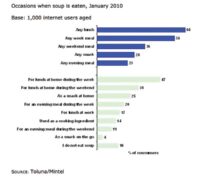 Retail value sales of soup have experienced strong growth in the last few, helped by their healthy perception. While penetration of the whole soup category has continued to fall, fresh chilled options have bucked the trend, and increased their penetration between 2005 and 2009. Since 2007, the UK market for soup has grown by 11% to reach £511 million in 2009. Soup is seen as a healthy/low calorie option by 19 million adults, although households with young children under 5yrs old are less interested.
Retail value sales of soup have experienced strong growth in the last few, helped by their healthy perception. While penetration of the whole soup category has continued to fall, fresh chilled options have bucked the trend, and increased their penetration between 2005 and 2009. Since 2007, the UK market for soup has grown by 11% to reach £511 million in 2009. Soup is seen as a healthy/low calorie option by 19 million adults, although households with young children under 5yrs old are less interested.
Soup is the ultimate in comfort food, especially when temperatures drop. The poor summer the UK faced in 2008, as well as the wet and cold winter, benefited the soup market. Ambient soup ranges experienced a 15% increase in sales between 2007 and 2009 as manufacturers like Heinz strengthened their portfolio of soup products, with the launches of new variants of its Farmers’ Market and Taste of Home ranges.
The soup market continued to prosper in early 2010 when the UK is reported to have experienced one of the coldest winters in 20 years, and the prolonged cold weather saw consumers buying soups to keep warm in the freezing weather.
Retailers experienced record sales of soups as consumers stocked up their cupboards when they could, as they were often unsure how often they would be able to leave their homes as the heavy snow meant that some households were blocked in their homes.
Consumer research reveals that 38% of consumers make their own soup from scratch, and a further 11% customise ready prepared soup. This exemplifies consumer’s longing for greater control over the food they eat, yet at the same time, their unending need for convenience.
Manufacturers need to ensure they promote soup all year round: as research finds as many as 17 million adults eat soup mainly when the weather is cold.
Manufacturers have done much to respond to healthy eating trends with the reformulation of their ranges, removing additives and preservatives.
The findings by CASH (Consensus Action on Salt and Health) in February 2010 that certain soup ranges contained unacceptably high levels of salt will put pressure on soup manufacturers to reformulate their ranges. They need to ensure that they take action quickly as consumers are paying closer attention to ingredients in their food, and backlash by consumers against the soup category will harm future growth prospects.
In terms of distribution, supermarkets are benefiting in the economic downturn as consumers substitute restaurant meals for more in-home dining. They have taken advantage of this opportunity, increasing their distribution share in the soup category. Today, supermarkets account for 92% of all sales.




Comments are closed.